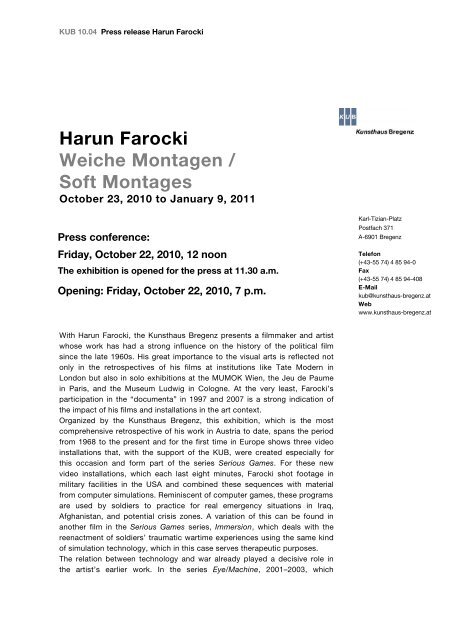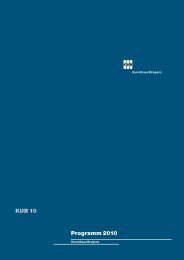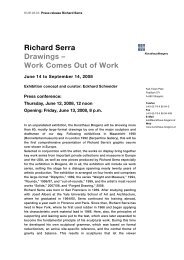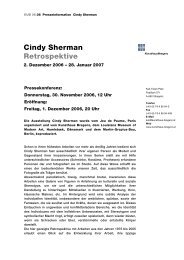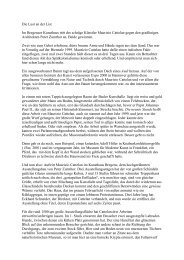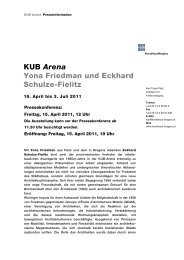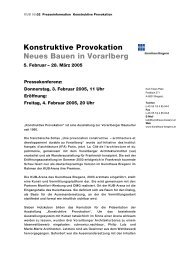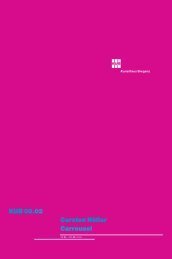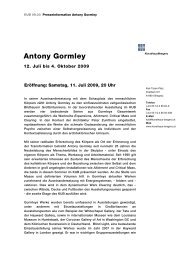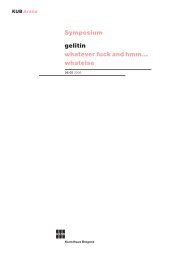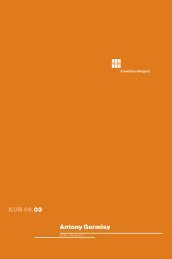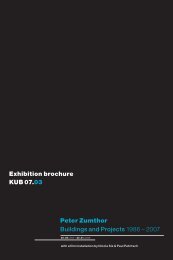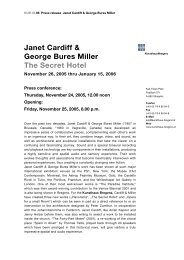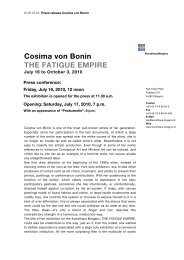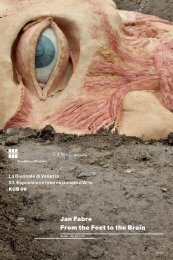Harun Farocki Weiche Montagen / Soft Montages
Harun Farocki Weiche Montagen / Soft Montages
Harun Farocki Weiche Montagen / Soft Montages
Create successful ePaper yourself
Turn your PDF publications into a flip-book with our unique Google optimized e-Paper software.
KUB 10.04 Press release <strong>Harun</strong> <strong>Farocki</strong><br />
<strong>Harun</strong> <strong>Farocki</strong><br />
<strong>Weiche</strong> <strong>Montagen</strong> /<br />
<strong>Soft</strong> <strong>Montages</strong><br />
October 23, 2010 to January 9, 2011<br />
Press conference:<br />
Friday, October 22, 2010, 12 noon<br />
The exhibition is opened for the press at 11.30 a.m.<br />
Opening: Friday, October 22, 2010, 7 p.m.<br />
With <strong>Harun</strong> <strong>Farocki</strong>, the Kunsthaus Bregenz presents a filmmaker and artist<br />
whose work has had a strong influence on the history of the political film<br />
since the late 1960s. His great importance to the visual arts is reflected not<br />
only in the retrospectives of his films at institutions like Tate Modern in<br />
London but also in solo exhibitions at the MUMOK Wien, the Jeu de Paume<br />
in Paris, and the Museum Ludwig in Cologne. At the very least, <strong>Farocki</strong>’s<br />
participation in the “documenta” in 1997 and 2007 is a strong indication of<br />
the impact of his films and installations in the art context.<br />
Organized by the Kunsthaus Bregenz, this exhibition, which is the most<br />
comprehensive retrospective of his work in Austria to date, spans the period<br />
from 1968 to the present and for the first time in Europe shows three video<br />
installations that, with the support of the KUB, were created especially for<br />
this occasion and form part of the series Serious Games. For these new<br />
video installations, which each last eight minutes, <strong>Farocki</strong> shot footage in<br />
military facilities in the USA and combined these sequences with material<br />
from computer simulations. Reminiscent of computer games, these programs<br />
are used by soldiers to practice for real emergency situations in Iraq,<br />
Afghanistan, and potential crisis zones. A variation of this can be found in<br />
another film in the Serious Games series, Immersion, which deals with the<br />
reenactment of soldiers’ traumatic wartime experiences using the same kind<br />
of simulation technology, which in this case serves therapeutic purposes.<br />
The relation between technology and war already played a decisive role in<br />
the artist’s earlier work. In the series Eye/Machine, 2001–2003, which<br />
Karl-Tizian-Platz<br />
Postfach 371<br />
A-6901 Bregenz<br />
Telefon<br />
(+43-55 74) 4 85 94-0<br />
Fax<br />
(+43-55 74) 4 85 94-408<br />
E-Mail<br />
kub@kunsthaus-bregenz.at<br />
Web<br />
www.kunsthaus-bregenz.at
2/7<br />
KUB 10.04 Press release <strong>Harun</strong> <strong>Farocki</strong><br />
consists of three separate installations and is being shown along with Serious<br />
Games on the first upper floor of the KUB, <strong>Farocki</strong> draws comparisons<br />
between surveillance mechanisms in belligerent conflicts and the use of<br />
cameras in civilian situations, e.g. to register motion in public places or to<br />
monitor operation sequences in high-tech industrial facilities.<br />
Comparison Via a Third, 2007, calls for a careful examination, a visual and<br />
cognitive scanning, of the aesthetically striking images of three<br />
geographically distinct production sites. This 2-channel 16-mm film<br />
installation as well as the split-screen video installation Counter-Music, 2004,<br />
and a comprehensive film library of 25 works are on display on the second<br />
floor. Comparison Via a Third shows a double video projection of brickyards<br />
and fired blocks being used to construct buildings in Africa, India, and<br />
Europe. Shot in the objective manner of a film documentary, this work gets<br />
by without spoken commentary, its impact deriving solely from the<br />
suggestive atmosphere of what is being presented. However, by merely<br />
showing the seemingly archaic production conditions prevalent in Indian<br />
high-rises, the film makes the viewer aware of parallels between different<br />
stages of industrialization within a society and in this way underscores the<br />
dubiousness of the traditional notion of progress.<br />
In Counter-Music <strong>Harun</strong> <strong>Farocki</strong> resorts almost exclusively to already existing<br />
material. This includes footage from sleep laboratories as well as surveillance<br />
and monitoring cameras that keep an eye on automobile, rail, and subway<br />
traffic as well as pedestrians. He compares images of the canal system and<br />
abstract display boards for the functioning of a place with living, organically<br />
pulsing bodies, and designs a portrait of the city in the tradition of films from<br />
the 1920s like The Man with the Movie Camera by Dziga Vertov or Berlin –<br />
Symphony of a Great City by Walter Ruttmann. Excerpts from both films can<br />
be seen in <strong>Farocki</strong>’s installation.<br />
<strong>Harun</strong> <strong>Farocki</strong>’s characteristic form of double projection is what enables him<br />
to produce both a regular succession of individual images and a simultaneity<br />
in their interrelationships. Despite the sometimes hard and unpredictable<br />
cuts, the jumping back and forth of images creates the soft montages that<br />
give the exhibition in Bregenz its title.<br />
One of <strong>Farocki</strong>’s best-known and most-loved works is certainly the piece that<br />
caused such a stir at the last “documenta,” Deep Play, which is being<br />
presented on the third upper floor of KUB. Twelve projection surfaces<br />
confront the viewer with different views of the final of the World Cup in 2006.<br />
Among the footage is not only material that was available to the normal<br />
viewer but also computer-generated abstractions of the game, vector<br />
measurements of the players’ bodies, and close-ups of individual players.<br />
The final, which was followed worldwide by 1.5 billion viewers in the summer
3/7<br />
KUB 10.04 Press release <strong>Harun</strong> <strong>Farocki</strong><br />
of 2006 and whose infamous headbutt by Zidane preoccupied soccer fans<br />
and laymen alike, is transformed into a metaphor of the complex relationship<br />
between entertainment, monitoring, battle, and the media.
4/7<br />
KUB 10.04 Press release <strong>Harun</strong> <strong>Farocki</strong><br />
KUB Billboards<br />
<strong>Harun</strong> <strong>Farocki</strong><br />
2010 – 2011<br />
October 4, 2010 – January 9, 2011<br />
Seestraße Bregenz<br />
For the KUB Billboards <strong>Harun</strong> <strong>Farocki</strong> selected a series of images and stills<br />
collected while researching his films as well as a number of production shots<br />
from the same projects. The artist writes the following about his approach:<br />
“Film work is generally represented by images of the film crew at work. But<br />
all forms of organizing images are also part of the craft of filmmaking and are<br />
as difficult to express as other organizational tasks. We work mainly with<br />
found images. For the pieces on warfare technology, Eye/Machine I–III, we<br />
searched various archives for years – public ones like the Washington Film<br />
Archive as well as different arms industry archives. And even when we<br />
travelled to the USA and shot footage inside military facilities, as was the<br />
case with Serious Games I–IV, at least half of our work consisted of copying<br />
images rather than producing new ones. Since our work mainly entails<br />
putting selected images into a given context, we chose multiple images for<br />
most of the billboards.”
5/7<br />
KUB 10.04 Press release <strong>Harun</strong> <strong>Farocki</strong><br />
KUB Publication<br />
<strong>Harun</strong> <strong>Farocki</strong><br />
In his films and video installations <strong>Harun</strong> <strong>Farocki</strong> deals with the sociopolitical<br />
dimension of moving pictures. He is most well known for films that are part<br />
fiction, part documentary and explore the controlling and surveillance<br />
function of the medium.<br />
This comprehensive catalogue being published in conjunction with the largescale<br />
solo show at the Kunsthaus Bregenz brings together informed essays<br />
by internationally renowned experts who discuss each of the works on<br />
display at the KUB. While Jan Verwoert’s contribution is a basic introduction<br />
to <strong>Farocki</strong>’s interdisciplinary oeuvre that spans the fields of art, film<br />
(documentary and fiction), and media studies, an interview between Yilmaz<br />
Dziewior and <strong>Harun</strong> <strong>Farocki</strong> addresses the current installation at the<br />
Kunsthaus Bregenz. The elucidating essays are accompanied by numerous<br />
images of all of the works and installations on display. Excerpts from<br />
<strong>Farocki</strong>’s journal – including unpublished material – round off the publication.<br />
<strong>Harun</strong> <strong>Farocki</strong><br />
German/English<br />
Ed. Yilmaz Dziewior<br />
Design: Wiebke Enwaldt, elemente3, berlin<br />
With contributions by Jan Verwoert, Christa Blümlinger, Stuart Comer,<br />
Seamus Kealy, Thomas Keenan, Matthias Rajmann, and a conversation<br />
between <strong>Harun</strong> <strong>Farocki</strong> and Yilmaz Dziewior<br />
Approx. 232 pages, 20 x 30 cm<br />
<strong>Soft</strong> cover with flaps<br />
Due to be published: December 2010<br />
Price: € 42
6/7<br />
KUB 10.04 Press release <strong>Harun</strong> <strong>Farocki</strong><br />
KUB Editions<br />
Close cooperation with the artists while planning the exhibition results in<br />
special editions designed exclusively for the Kunsthaus Bregenz.<br />
Candice Breitz<br />
New York, New Yorkers | 2009<br />
Offset print<br />
60 x 90 cm<br />
Limited edition of 250 pieces, numbered and signed<br />
Price: € 80 (incl. 10% VAT) plus forwarding expenses<br />
Cosima von Bonin<br />
POODLE OR NOT | 2010<br />
2 photographs sewn together and 1 shirt (sizes: S, M, L, XL)<br />
30 x 20 cm<br />
200 pieces (each one of a kind), numbered and signed<br />
Price: € 180 (incl. 10% VAT ) plus forwarding expenses
7/7<br />
KUB 10.04 Press release <strong>Harun</strong> <strong>Farocki</strong><br />
Partners and Sponsors<br />
The Kunsthaus Bregenz would like to thank its partners for their generous<br />
financial support and the cultural commitment that goes along with it.<br />
Panorama page <strong>Harun</strong> <strong>Farocki</strong> in cooperation with the VN and the KUB<br />
In conjunction her exhibition <strong>Harun</strong> <strong>Farocki</strong> will create a Panorama page to be<br />
published in the VN on October 16. <strong>Harun</strong> <strong>Farocki</strong> will be available to autograph this<br />
page on October 23, from 12 noon till 1 p.m. at the Kunsthaus Bregenz.
8/7<br />
KUB 10.04 Press release <strong>Harun</strong> <strong>Farocki</strong><br />
Kunsthaus Bregenz<br />
Venue/Organizer:<br />
Kunsthaus Bregenz<br />
Karl-Tizian-Platz<br />
A-6900 Bregenz<br />
Director<br />
Yilmaz Dziewior<br />
Chief executive<br />
Artur Vonblon<br />
Curator<br />
Rudolf Sagmeister<br />
Curator of the KUB Arena<br />
Eva Birkenstock<br />
Press and public relations<br />
Birgit Albers<br />
Phone: (+43-55 74) 4 85 94-413<br />
Fax: (+43-55 74) 4 85 94-408<br />
b.albers@kunsthaus-bregenz.at<br />
Press photos to download<br />
www.kunsthaus-bregenz.at<br />
Art Education<br />
Winfried Nußbaummüller<br />
Phone: (+43-55 74) 4 85 94-417<br />
Fax: (+43-55 74) 4 85 94-408<br />
w.nussbaummueller@kunsthausbregenz.at<br />
Publications/editions<br />
Katrin Wiethege<br />
Phone: (+43-55 74) 4 85 94-416<br />
Fax: (+43-55 74) 4 85 94-408<br />
k.wiethege@kunsthaus-bregenz.at<br />
Sales Editions<br />
Caroline Schneider<br />
Phone: (+43-55 74) 4 85 94-444<br />
Fax: (+43-55 74) 4 85 94-408<br />
c.schneider@kunsthaus-bregenz.at<br />
Opening hours<br />
Tuesday – Sunday 10 a.m. – 6 p.m.<br />
Thursday 10 a.m. – 9 p.m.<br />
24.12.10 10 a.m. – 2 p.m.<br />
25.12.10 closed<br />
26.12.10 10 a.m. – 6 p.m.<br />
31.12.10 10 a.m. – 2 p.m.<br />
01.01.11 2 p.m. – 6 p.m.


